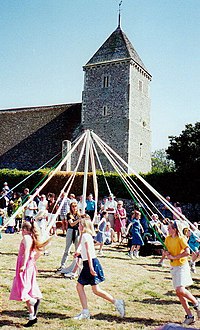а ось що насправді люди святкували на May Day
May Day is a public holiday usually celebrated on 1 May. It is an ancient Northern Hemisphere spring festival[1] and a traditional spring holiday in many cultures. Dances, singing, and cake are usually part of the festivities.

Morris dancing Botanical gardens Oxford 1st May 2018
The earliest known May celebrations appeared with the Floralia, festival of Flora, the Roman goddess of flowers, held on 27 April during the Roman Republic era, and the Maiouma or Maiuma, a festival celebrating Dionysus and Aphrodite on an unknown date in May every three years.[3] The Floralia opened with theatrical performances. In the Floralia, Ovid says that hares and goats were released as part of the festivities. Persius writes that crowds were pelted with vetches, beans, and lupins. A ritual called the Florifertum was performed on either April 27 or May 3,[4][5] during which a bundle of wheat ears was carried into a shrine, though it is not clear if this devotion was made to Flora or Ceres.[6][7] Floralia concluded with competitive events and spectacles, and a sacrifice to Flora.[8]
According to the 6th century chronicles of John Malalas, the Maiouma was a "nocturnal dramatic festival, held every three years and known as Orgies, that is, the Mysteries of Dionysus and Aphrodite" and that it was "known as the Maioumas because it is celebrated in the month of May-Artemisios". During this time, enough money was set aside by the government for torches, lights, and other expenses to cover a thirty-day festival of "all-night revels."[9] The Maiouma was celebrated with splendorous banquets and offerings. Its reputation for licentiousness caused it to be suppressed during the reign of Emperor Constantine, though a less debauched version of it was briefly restored during the reigns of Arcadius and Honorius, only to be suppressed again during the same period.[10]
A later May festival celebrated in Germanic countries, Walpurgis Night, commemorates the official canonization of Saint Walpurga on May 1st, 870.[11]. In Gaelic culture, the evening of April 30th was the celebration of Beltane (which translates to "lucky fire"), the start of the summer season. First attested in 900 AD, the celebration mainly focused on the symbolic use of fire to bless cattle and other livestock as they were moved to summer pastures. This custom continued into the early 19th century, during which time cattle would be made to jump over fires to protect their milk from being stolen by fairies. People would also leap over the fires for luck.[12]
Since the 18th century, many Roman Catholics have observed May – and May Day – with various May devotions to the Blessed Virgin Mary[13] In works of art, school skits, and so forth, Mary's head will often be adorned with flowers in a May crowning. 1 May is also one of two feast days of the Catholic patron saint of workers St Joseph the Worker, a carpenter, husband to Mother Mary, and surrogate father of Jesus.[14] Replacing another feast to St. Joseph, this date was chosen by Pope Pius XII in 1955 as a counterpoint to the communist International Workers Day celebrations on May Day.[14]
https://en.wikipedia.org/wiki/May_Day
 Автор
Тема: Свято наближається!!!!!!!! (Прочитано 270956 раз)
Автор
Тема: Свято наближається!!!!!!!! (Прочитано 270956 раз)
